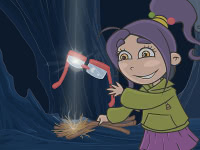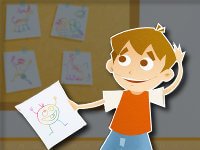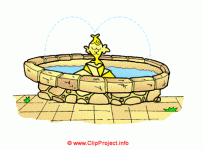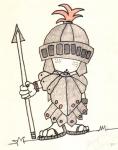How to create a good story in less than a minute
Tap the calamus image below to get free access to our best collection of stories for children with related activities. Download it to enjoy our stories whenever you want
Advertisement
![]() Where to start? Download our free Workbook of Values, watch our animated stories and enjoy Jakhu Stories, our stories for kids app
Where to start? Download our free Workbook of Values, watch our animated stories and enjoy Jakhu Stories, our stories for kids app
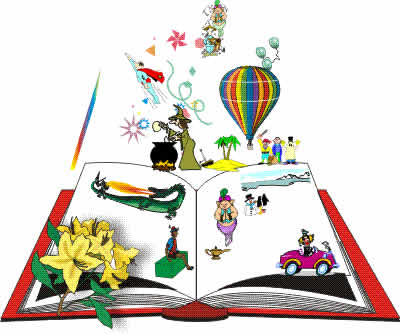 Once upon a time there was a father who wanted to use stories to educate his children.
Once upon a time there was a father who wanted to use stories to educate his children.
Looking into it, he came across a lot of advice, but the whole thing seemed so difficult that he decided to give up.
That same day, his daughter came to him, crying: "I can't tie my laces, it's too difficult, boo-hoo!! I'll never be able to do it!"
Her father tried cheering her up: "You'll soon learn how; it's very easy. You just have to make an effort to practice a little." On saying these words he realised that he had been the first to abandon a project that day...
So, that night, he made up a story for his children, though it wasn't great. The next night he tried again, and it was a bit better. After a few days, having practiced and continued learning, his stories turned out wonderfully. Now story-time had become the best time of the whole day, both for him and his children.
Does this story remind you of anyone? Right now it's my own story, but it could be yours too within a matter of days... keep reading and I'll tell you how.
Few are they who have the time to look for a new story every day to tell their kids. The only quick solution is to make one up on the spur of the moment. However, the great majority of parents don't consider themselves sufficiently creative to invent a new story every day. But it's actually a lot easier than it might seem.
Here is a short guide containing the steps to follow to create a new story each day. Most stories intended for children have a very simple structure. Although the characters and setting can vary widely, almost all the stories are similar. This is especially true for stories with some kind of moral to them.
The plot always deals with some problem or obstacle which...
... and which is resolved by applying that value or virtue.
So, to sum up, when formulating a story, you will need:
It doesn't seem like much, but with just that the story is almost done. Now I'm going to tell you how I do it; how I come up with those elements, and how I put them together. To demonstrate this bit by bit, as an example I will use a story I made a couple of days ago. The Mocking Tiger".
The first thing I do is decide what I want to get across in the story; the moral.. I start there because, of all the elements, that is definitely the most important when telling my children a story. Usually I try to make it have something to do with something which happened that day. Something the children did well or poorly, and that will still be fresh in their minds. This makes it easier for children to relate to the story.
It's very useful to start with the moral because it helps you to situate the rest of the story, and puts the story at the service of the message you want to impart. Generally, I start thinking about what I want to teach them that day, when it's not long until bedtime, (when we're finishing supper, or brushing teeth), so that I have some time to decide on the moral, and to think up a problem that can be solved by applying that moral. In the case of the tiger story, what I wanted to teach them was that everyone is important in some way, even though that may not appear to be the case.
Once they're in bed, and I know what message I'm going to be communicating to them, the next thing to do is choose the characters. Usually, each child chooses a character, and I choose the last one. Although it might seem difficult, whenever you have an idea of what kind of problem the story will have to solve, the choice of characters enables the plot to be easily adjusted to what we want to get across. It's at the moment I choose the character which best fits the story that the story starts to emerge. In the case of the tiger story, my children chose an elephant and a bumblebee as their characters. Because I wanted to talk about limitations their choices made it very easy for me: one fat and slow, the other small and insignificant. So the plot arose naturally. If I chose an animal who pokes fun at them it would be easy to demonstrate that those limitations can be an advantage in certain situations.
So I chose the tiger - who I could portray as a fast, strong, and clever animal - who had the unpleasant habit of belittling everyone, including the elephant, who he called fat and slow; and the bee who he called tiny and weak.
Next it's time to introduce the problem or obstacle. As you can see, the characters themselves contribute to this, since it will be something which can be resolved with the help of the moral we're trying to get across. In the case of the tiger story, how to demonstrate that what some see as a bad characteristic can turn out to be very useful?
With an elephant and a bumblebee it's clear that the characteristic to choose will be size.
So I sought a situation in which the two extremes of size could be of use. Just then it occurred to me that all animals could be trapped inside a cave after a landslide had covered the entrance... all except the elephant who would be the only one capable of moving the rocks. The bee would be the only one who could escape, from between the rocks, to go and get the elephant to help.
Finally, one has to place emphasis on the moral of the story.. Whenever I more or less know how the story is going to go (and that process doesn't take more than a couple of minutes), I start to tell it, being sure to emphasise the values I want to educate the children about. For this I use whichever part of the story which I deem to be more or less fitting. I finish by concentrating on the particular teaching inherent in the story, and in a positive way. In the case of the tiger, I highlighted the way he abused his position of superiority, using it to make fun of everyone else. And I stressed that when the animals were trapped in the cave the tiger continued being conceited, even though he achieved nothing. I brought out the fact that when the bee and the elephant rescued all the animals, the animals considered them heroes, and everyone wanted to be their friend. I also emphasized how embarrassed the tiger felt, and how he was the last to leave the cave. He regretted not having realized the exceptional abilities belonging to, not only the elephant and bee, but also the kangaroo, the owl, the giraffe, and everyone.
Of course, the story ended up confirming that the tiger had learned a great deal, and had changed his attitude. Now, instead of everyone being afraid of him and disliking him, they were all happy to be his friend, because now he spoke well of everyone.
And that's it. You can see that it doesn't take much to create a story fit for any requirement, and how easy it is to start, from right now, making your own educational stories.
Though that's not the whole story.
How to tell a story is another - equally important - element, which I haven't gone into here. But you can find more on that in the article "How to tell bedtime stories".
Back to children stories
Discover Storytelling benefits
Learn How to tell Bedtime Stories
Search for Stories within our huge collection



